 |
||
|
|
|
Celebrating the pipe organ, the King of Instruments |
Pipedreams Euro-Tour
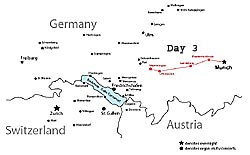 |
April 28 - May 11, 2006
Day 3 - Fürstenfeldbruck, Landsberg, Ottobeuren & Memmingen
 Notes from the Road - travel log, day 3
Notes from the Road - travel log, day 3 Michael Barone’s pictures from the tour
Michael Barone’s pictures from the tour Images from Fürstenfeldbruck
Images from Fürstenfeldbruck Images from Landsberg
Images from Landsberg Images from Ottobeuren
Images from Ottobeuren Images from Memmingen
Images from Memmingen Day 2 - Munich
Day 2 - Munich Day 4 - Rot, Ochsenhausen & Ulm
Day 4 - Rot, Ochsenhausen & Ulm Main Tour Page
Main Tour Page
Fürstenfeldbruck
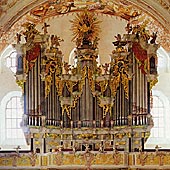 |
West of Munich, the city of Fürstenfeldbruck (with a present-day population of 35,494) originated as the old bridge village, Bruck, which served as a mid-12th century customs station on the so-called “salt street” from Munich to Augsburg. In medieval times the region was a clerical state ruled by the Cistercian abbey of Fürstenfeld, which was founded in 1263. When the clerical states of Germany were dissolved in 1803, the territory was annexed by Bavaria. On October 1, 1935, Fürstenfeldbruck became a city and today is the European management center for the American firm National Semiconductor, also home to a Coca-Cola bottling plant and an air force base (site of the tragic ‘Munich Massacre’ during the 1972 Summer Olympics). The monastery of Fürstenfeld, a masterpiece of Bavarian baroque architecture and one of Bavaria’s most magnificent churches, achieved it’s present
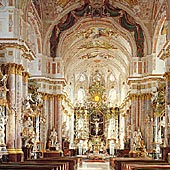 |
The Fürstenfeldbruck organ is considered the best preserved Baroque organ in the Altbayern region. Built in 1736 by Johann Georg Fux (1670-1738) from Donauworth, this instrument was restored in 1977/78 by Hubert Sandtner from Dillingen/Donau.
Links and resources
 Notes from the Road - travel log, day 3
Notes from the Road - travel log, day 3 Images from Fürstenfeldbruck
Images from Fürstenfeldbruck Find detailed organ specifications in our Tour Book
Find detailed organ specifications in our Tour Book
| Return to top |
Landsberg (Stadtkirche Maria Himmelfahrt)
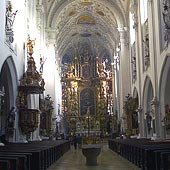 |
The Gothic city church has been built between 1458 and 1488 at the site of two previous church buildings. From these older churches (late 13th century) several parts are preserved like the lower part of the tower, the tympanon and the baptism font. Between 1678 and 1708, the church’s interior has been rebuilt in Baroque style. The precious stained glass windows in the chancel are from 15th and 16th centuries.
When in the course of the church’s Baroque rebuilding a new high-altar had been built in 1678-80, a new Baroque organ on the west gallery had been built as a counterpart by David Jacob Weidtner from Augsburg in 1689. In the following decades, this organ had been repaired and rebuilt by Johann Pez (1701), Alexander Holzhey (1767) and Franz Thoma (1782). When the Weidtner organ became unplayable, Jakob Kölbl from Wessobrunn built a new instrument in 1792. Paul Hörmüller from Landsberg repaired the organ in 1800 and added to this 15-stop-organ (still in the case of Weidtner, 1689) further 3 pedal stops and two positiv cases on the gallery with 6 stops each. Hörmüller also built a new choir organ with 8 stops in 1849, placed on the North choir gallery, which replaced an older instrument from Alexander Holzhey (1762).
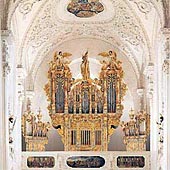 |
Gerhard Schmid from Kaufbeuren rebuilt the organ completely in 1979-1983 and enlarged it to V/82.
In 2001, Siegfried Schmid from Immenstadt rebuilt the instrument again and it was reduced to IV/68 (west gallery organ with 60 stops, choir organ with 8 stops). The entire actions, including trackers and roller boards, as well as the console and bellows have been built new. In addition, a new Tuba mirabilis with own wind supply (450 mm WS) was added, after patterns from English Willis organs.
Links and resources
 Notes from the Road - travel log, day 3
Notes from the Road - travel log, day 3 Images from Landsberg
Images from Landsberg Find detailed organ specifications in our Tour Book
Find detailed organ specifications in our Tour Book
| Return to top |
Ottobeuren (Basilica)
The Benedictine abbey, near Memmingen in the Bavarian Alps, was founded in 764 by Blessed Toto, and dedicated to Saint Alexander, the martyr. It was created as a family monastery of the counts Silach. Monks came from the Bodensee ares, i.e. Saint Gallen and Reichenau. In the 11th century, Abbot Adalhalm restored the decaying buildings and began the construction of a chapel dedicated to Saint Nicolas that was consacrated in 1126. While a laxity in discipline was setting in, his successor, Abbot Rupert I introduced the Hirsau reform. A religious bloom followed that reached its peak under the direction of Abbot Isingrim In 1153, and again in 1217, the abbey was consumed by fire. In the 14th and 15th centuries, the abbey declined considerably. Under Abbot Leonard Wiedemann (1508-46), the abbey began to flourish again: he erected a printing establishment and a common house of studies for the Swabian Benedictines.
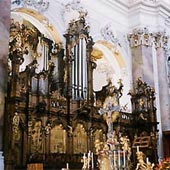 |
The most flourishing period in the history of Ottobeuren began with the accession of Abbot Rupert II Ness (1710-40) and lasted until its secularization in 1802. From 1711 to 1725, Abbot Rupert II erected the present monastery, the architectural grandeur of which has merited for it the name of “the Suabian Escorial”. In 1737, he also began the building of the present church that was designed by Johann Michael Fischer. It became one of the masterwork of the European baroque. It was completed by his successor, Anselm Erb, in 1766. In the zenith of its glory, Ottobeuren fell a prey to the greediness of the Bavarian Government. After the dissolution of the monastery in the secularization in 1802, it owes to the loyalty of the 48 monks at that time, which could not be driven out neither by chicaneries nor by national coercive measures, that the monastery, under King Ludwig I of Bavaria, in 1834, was restored as a Benedictine priory, dependent on the abbey of Saint Stephen at Augsburg. Since 1918, Ottobeuren is again an independent abbey. In 1926, Pope Pius XI granted the status of “minor basilica” to the abbey church.
Links and resources
 Notes from the Road - travel log, day 3
Notes from the Road - travel log, day 3 Images from Ottobeuren
Images from Ottobeuren Specification & Pictures from Die Orgelseite
Specification & Pictures from Die Orgelseite Exterior view of monastery
Exterior view of monastery Specification of the Riepp organ
Specification of the Riepp organ Find detailed organ specifications in our Tour Book
Find detailed organ specifications in our Tour Book
| Return to top |
Memmingen (Saint Martin’s Church)
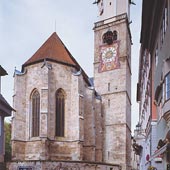 |
Saint Matin’s Chapel was first mentioned in the 8th century and was replaced in 1176 by a larger edifice. The chancel and tower of today’s church were completed at the end of the 14th century, and the whole church was further enlarged during the entire 15th century: the Gothic city church was completed in 1500. Ornamental decoration and oil paintings were added to the interior in 1587 and 1708 respectively. The church tower is a prominent landmark of the town of Memmingen, with a clock face dating from 1524 and the octogon spire (home of the night watchman during the Middle Ages) from 1537.
The first significant organ in Saint Martin was mentioned in 1598. Exactly 400 years later, the present organ was completed, another remarkable instrument of 62 speaking stops built by organbuilder Goll from Lucerne, Switzerland. The organ was inaugurated on November 8, 1998.
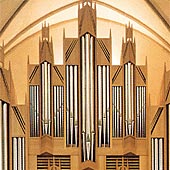 |
The large and impressive interior of the sanctuary (215 feet long, 60 feet high), as well as the bass-weakening acoustics, have been of considerable influence to the musical conception of the new organ. It was thought that only an instrument that derives its powers from the reed stops, rather than from the mixtures, would fill this room adequately, hence the French design of the specifications. The finishing touch is a set of three horizontal reed stops, placed behind the Hauptwerk division. A specialty are the six harmonic flute stops in the Swell division.
Links and resources
 Notes from the Road - travel log, day 3
Notes from the Road - travel log, day 3 Images from Memmingen
Images from Memmingen Specification from Die Orgelseite
Specification from Die Orgelseite Find detailed organ specifications in our Tour Book
Find detailed organ specifications in our Tour Book
| Return to top |


